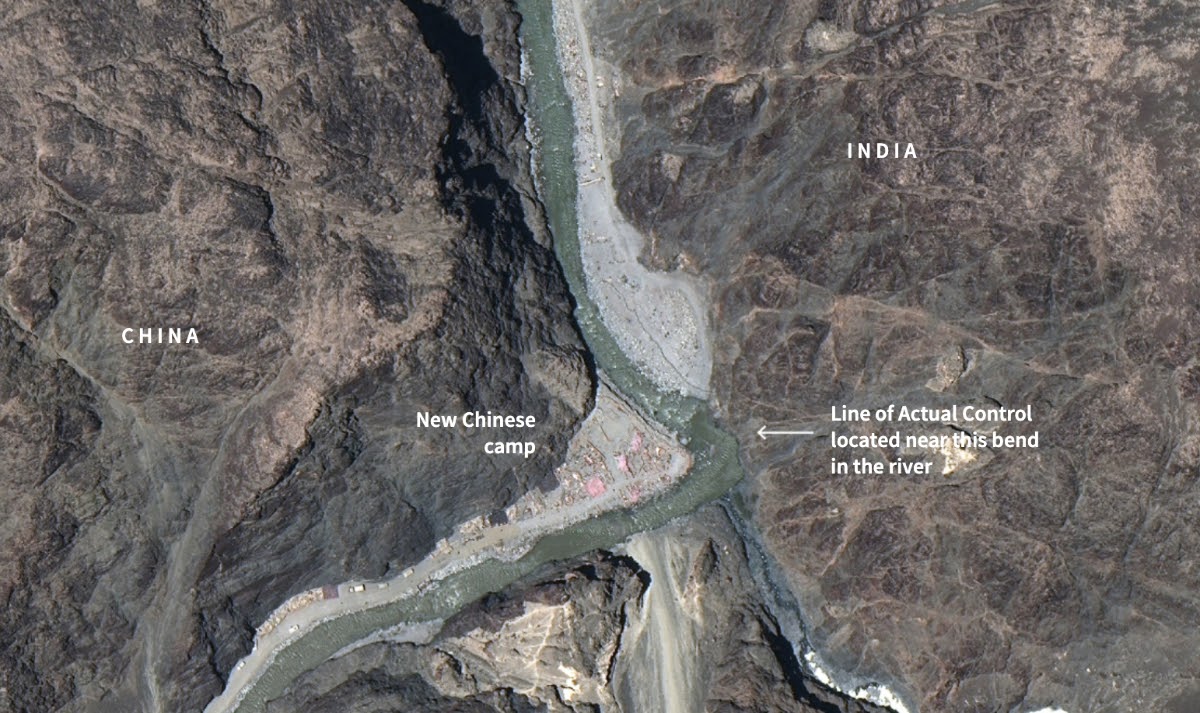China accuses India of ‘vile’ acts on border
Tensions remain high in the Himalayas, 10 days after the violent clash that left 20 Indian soldiers dead and, according to both named and anonymous Chinese official sources, a small number of Chinese soldiers with injuries.

Screenshot of a June 22 Maxar Technologies satellite image of the site of the China-India border clash, as labelled by Reuters.
Tensions remain high in the Himalayas, 10 days after the violent clash that left 20 Indian soldiers dead and, according to both named and anonymous Chinese official sources, a small number of Chinese soldiers with injuries.
“The acts of the Indian army are of a vile nature and have severe consequences,” said Chinese Foreign Ministry spokesperson Zhào Lìjiān 赵立坚 at a press briefing in Beijing (English, Chinese). Zhao started the briefing by articulating Beijing’s version of events, which involves a Line of Actual Control (LAC) that is “clear,” an Indian army that repeatedly crossed that line to build infrastructure, and Indian troops who attacked Chinese army officers and soldiers in an “abrupt and violent manner” when they came to negotiate. The account is similar to what Zhao articulated on June 19, but the “vile nature” (性质恶劣 xìngzhì èliè) comment is new.
The Chinese ambassador to India, Sūn Wèidōng 孙卫东, gave an interview to the Press Trust of India today in which he repeated the exact same version of events — without the “vile nature” comment — but with more detail on the various agreements and understandings that China believes India to have violated.
“At the heart of the matter is that since early May the Chinese side had been amassing a large contingent of troops and armaments along the LAC,” a spokesperson for the Indian foreign ministry countered, per Reuters. The spokesperson, like Sun Weidong, accused the other side of violating a 1993 treaty on border deployments.
Whatever happened in the Himalayas 10 days ago, the armies of Asia’s two largest nuclear powers are not “disengaging,” as was previously described:
“China appears to have added new structures near the site of a deadly border clash with India in the western Himalayas, fresh satellite pictures show,” Reuters reports. “On the Indian side, defensive barriers can be seen in the latest images which were not visible in pictures taken in May,” Reuters adds. The images are dated June 22. See also two tweets from Nathan Ruser, a satellite data expert at the Australian Strategic Policy Institute:
- Tweet 1: “Satellite imagery from the Galwan Valley on June 22nd shows that ‘disengagement’ really isn’t the word that the government should be using. This gif shows the small outpost that sparked the June 15th clashes. It has grown hugely in size. Indian troops aren’t dismantling this one.”
- Tweet 2: “New details of the satellite imagery from June 22nd also show another curious feature, a new patrol route from the forward Indian base to the ridgeline that marks the LAC. Spare a thought for any soldier needing to climb that hill!”
Indian military activity has also ramped up in Ladakh, which borders the Galwan Valley, according to Al Jazeera:
Indian jets regularly took off on Wednesday from a military base in Leh, the main Indian town in the contested Indian-administered Ladakh region, and headed towards the mountainous border 240km (150 miles) away.
There were also checkpoints on main roads outside Leh and a frenzy of military activity around the main town, which lies at an altitude of 3,500 metres (11,500 feet).
Residents reported long lines of military trucks and artillery on roads near Leh.






